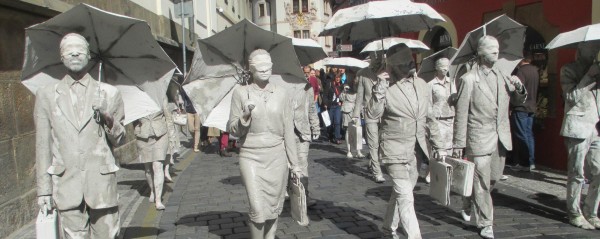

Photo Credit / Madison Petro
By Madison Petro
SC Staff Writer
Two of East Stroudsburg University’s current theatre students, Christopher Robinson (junior) and myself, Madison Petro (sophomore), along with four alumni, Michael Lloret, Rebecca Regina, Robert McIntyre and Ahleea Zama, attended the Prague Quadrennial of Performance Design and Space in Prague, Czech Republic from June 18 through June 26, 2015.
The Prague Quadrennial, or PQ, is “the largest scenography event in the world,” according to the PQ website, which exhibits many different design elements including stage, costume, sound and lighting design, as well as site specific scenography and performances.
The PQ has four main exhibition categories: National, Thematic, Architectural, and Student, that have helped shape theatre and performance since the event started forty years ago.
The Prague Quadrennial had similar elements to the Kennedy Center American College Theatre Festival (KCACTF), which Robinson, Lloret, and Regina attended this past January.
The main difference was that PQ focuses on design, while KCACTF focuses on performance.
With student and country exhibitions, tribal site-specific performances, and movement pieces relying heavily on lighting and sound design, Robinson believes PQ “will give you a new look on your profession as an artist.”
Along with attending PQ, we also visited the National Theatre, “Národní Divadlo” in Czech, and saw some amazing plays and operas.
The design concept that was the biggest hit among our ESU group was the Mexican boat tour.
On this gondola-like boat, or trajinera, passengers were informed about the water shortage in Mexico and what we can do to help.
Lloret, feeling a connection with how this crisis affects people and the need for a call to help, was interviewed for a project the Mexican students and professors are working on.
The trajinera was designed with traditional Mexican decorations and took us around the Vltava River, which runs below the famous Charles Bridge, known as Karlův Most to the locals.
Not only is Prague home to the Charles Bridge, which is lined with statues built in the fourteenth century during the time of King Charles IV (and eventually Holy Roman Emperor), it also has many other mesmerizing sites to see.
There is the Astronomical Clock in Old Town Square, with a short “show” every hour, on the hour. The John Lennon Wall is there, covered in graffiti with messages of love and wonder.
There is also the Prague Castle, listed as the largest ancient castle in the world according to the Guinness Book of World Records.
On our third day in Prague, we took a trip to Terezin, which was a concentration camp during World War II and a military fortress for many years before.
We saw the terrifying conditions the people lived in there under Nazi rule; living in literal animal stables and similar sized rooms crammed with more people than they were made for.
We learned that the only reason Prague was left the way it is today was because Hitler wanted to preserve it as a memorial for the “lost race,” that he planned for the Jewish to become.
If the people of then Czechoslovakia had rebelled against the Nazis however, Prague would have been destroyed and we would not have had the chance to see the beautiful city it was, and is, today.
The street vendors offered mouthwatering food choices, too. “Old Style Prague” cooked sausages were one of the favorites among our group, as well as the traditional Trdelnik pastries, that were turned over hot coals, sprinkled with sugar and nuts, and occasionally filled with Nutella.
My personal favorite part of our trip was the time we spent exploring and discovering new places.
I once went exploring on my own to find PQ exhibits outside of the main section and ended up where people spoke little to no English. Somehow, even with language barriers, I still found a way to communicate with the locals and I thought that was amazing.
The Prague Quadrennial was a fantastic experience for all of us and we hope many other students have the chance to go. It is a great opportunity for performers to see their work in a different perspective, for designers to share their insights, and for both students and professionals to network internationally.
Prague, located in part of Bohemia, is a must-see that is filled with history, architecture, art, and so much more.
Email Madison at:
mpetro3@live.esu.edu
